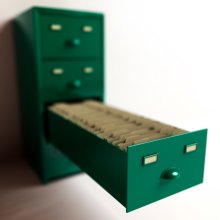Easy go, easy come
Datum: 2009-12-30 12:00

What do you do with all that good-to-have-material, your reference material, the things you need from time to time that are so simple to put in piles so it won’t get lost, and which you then never find when you need them the most, just because they are somewhere at the bottom of the piles?
The whole idea with this type of material is for it to be out of your way when you don’t need it, it should be easy to put away and easy to find whenever you need it.
My personal favourite solution to this problem is a carefully thought-out suspension filing system.
Try this
Get yourself a large set of suspension folders and a suitable box to keep them in (or an old charming filing cabinet if you prefer that). Tag the folders with the letters of the alphabet, one folder for each letter, and place them in the box.
Close the door, switch off your telephone and if you have a shared calendar system at your office, book a one hour long meeting with yourself. Bring out the first pile. Go through it item by item and throw away everything you won’t need again, and sort the material you want to be able to find later under a suitable letter in the filing system.
What will your search phrase be?
When you choose a letter to file your material under, think about what “search phrase” you would use when you want find it again. If it is a typical potential client, a prospect, then file it under the letter P, as in prospects or potential client. Is it a possible speaker for a future seminar, file under S as in speaker. If the material unquestionably concerns your former client Acme Industries, it obviously ends up under the letter A.
Dedicated folders
If you think of an area (a certain customer, or project, etc) which definitely will contain a lot of data or material, create a separate folder and place it in the alphabetical order among the rest of the suspension folders.
Always make sure you have got a supply of empty folders. This will make it easier for you to create a new dedicated folder whenever you need one. If it takes the slightest effort to file things away, the risk is that you ignore it and either put the material in a stack for sorting “later” or put it in one of the standard folders, where you will have trouble finding the right paper when you need it the most. If you find it too hard to locate the data you are looking for, you will experience that suspension folders aren’t your thing, and you will soon be back to piles again.
Good looks takes effort, but it might be worth it
If it is important for you, for instance, what the labels look like, then take your time to carefully write them in a way that appeals to you, making it a pleasure to browse through the folders. If it is more important to get the material out of your way quickly, write them in a way that is easy and quick, so that the labelling itself doesn’t turn into an obstacle.
Too easy to be true?
OK, this may sound like a very conventional and simple solution, but trust me when I say that there are more piles of paper around than suspension filing systems.
A well-constructed suspension filing system is a just as easy as it is genius, way to keep your desk and office clear of papers you don’t need right now, at the same time as it makes it very easy to find them when you do need them.
The next three, voluntary, steps
- If you want to, decide right now how many suspension folders you will buy, when you will buy them and where.
- Decide where you will keep them.
- Schedule in your agenda right away that particular hour when you will browse the first pile.
Do you do it differently?
If you’re not a fan of suspension folders at all and maintain another system entirely to get rid of the piles, tell me about it in a comment below.




